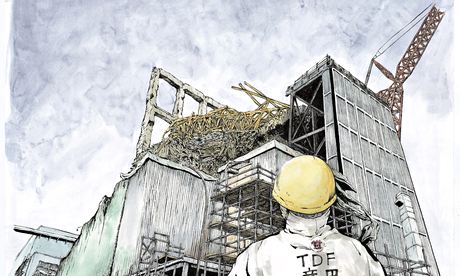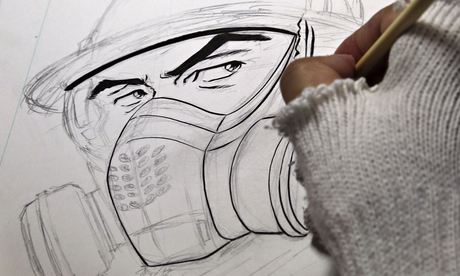福島事故中 九成員工「違令逃離」
更新時間 2014年5月20日, 格林尼治標準時間17:33

穿著防護服的福島核電站員工在核儲藏庫前
日本《朝日新聞》引述已故福島第一核電站站長吉田昌郎(2013年去世)的記錄報道稱,當2011年福島核洩漏事故發生時,九成電站工人逃離現場。
據報,《吉田調查記錄》是事故負責人在接受日本政府事故調查和驗證委員會問詢時所作的記錄。
記錄顯示,在日本東部大地震發生四天後,90%第一核電站的員工(約650人)沒有服從吉田站長原地待命的指令,撤退至十公里外的第二核電站。 記錄指稱,這可能是後來輻射量激增、事故未能及時得到控制處理的原因之一。
報道說,東京電力公司對於上述有關員工「違反命令逃離現場」的真相隱瞞了三年之久。
臨危逃離?
據報,《吉田調查記錄》和東京電力公司資料顯示,2011年3月15日晨6點15分,由吉田指揮的第一
核電站免震重要棟2層的緊急對策室收到了重大報告:核反應堆壓力控制室內的壓力已變成零,2號機組的核反應堆安全殼即將破損,720名員工有可能被暴露在
高輻射線下,「現場沉浸在濃重危機感中」。
吉田站長在6點42分,並未按照早前計劃發出「向第二核電站撤退」指令,而是通過公司內部的電視會議命令「暫時從高輻射量的地方撤退,在能馬上返回現場的第一核電站區域內待命」、「躲避在站內輻射量低的地方,在確認沒有異常後返回」。
不過,吉田的證言記錄顯示,多數員工不顧命令,上午7點左右就乘坐巴士離開; 另有站員駕駛私家車撤離 第一核電站,造成九成員工實際已經離開現場的現實。
東京電力公司長時間未對外公示吉田站長事故發生時的「原地待命」指令。
東電管理方最新的表示是,吉田當時的指令並非嚴格的命令。
據悉,在擅自撤離的員工中還包括指揮應對事故、被稱為「GM」(組長)的部科長級領導力量。據調查結果顯示,這些組長有可能違反了「在發生重大事故時支援核反應堆的運轉和控制」的公司內部規定。
最終留守的只有站長吉田等69人。當天中午時分,站員才陸續開始從第二核電站返回。這期間,第一核電站的2號機組噴出了白色蒸氣狀物質,4號機組發生了火災。核電站正門處檢測出了最高輻射值。
《吉田調查記錄》
由日本政府事故調查委員會以問答形式實錄的《吉田調查記錄》,據悉調查時間累計為29小時16分(包括休息時間 1小時8分)。
有關調查從2011年7月22日起至11月6日為止,共進行13次調查。其中,就事故原因和初期應對的詢問調查為11次,由調任至委員會事務局的檢察官擔任詢問員。
政府事故調查委員會共聽取了772人計1479小時的口供,平均每人約1.9小 時。該記錄原件保存在日本內閣官房。
(編譯:晧宇 責編:董樂)
文件稱福島核電站員工核泄漏後抗命逃離現場
MARTIN FACKLER 2014年05月21日

Nuclear and Industrial Safety Agency, via Agence France-Presse — Getty Images
福島核電站被損毀的樓房。
東京——日本一家主要報紙周二報道了一份此前未公布的有關福島核電站災難的記錄,該記錄顯示,三年之前,在福島核電站危機最危急的時刻,數百名恐慌的員工儘管接到了堅守崗位、盡最後努力重新控制失控反應堆的命令,但卻依然逃離了受損的核電站。
《朝日新聞》(The Asahi
Shimbun)稱,在2011年3月的前述災難發生幾個月後,災難發生時擔任福島第一核電站(Fukushima Daiichi
plant)站長的吉田昌郎(Masao
Yoshida)曾在政府調查人員進行的一系列訊問中描述了這一事故。該報稱自己已獲得一份長達400頁的訊問文字記錄副本。政府對這一事件的描述提及了
這些訊問,但訊問內容此前從未完整公布。
這份文字記錄可能是吉田昌郎為這一事故留下的唯一一份證詞,他已於去年死於癌症,享年58歲。日本人普遍認為,吉田昌郎是這場災難中的少數幾位英雄之一,這些人無視停止向過熱反應堆注入海水的命令,阻止了危機失控。
這些文字記錄讓人們對那些驚慌工人在3月15日的表現有了
一些令人膽寒的了解,當時是一次嚴重地震和海嘯摧毀該核電站關鍵冷卻系統四天之後,核電站似乎在崩潰的邊緣搖搖欲墜。吉田昌郎對調查人員稱,650名工人
乃至中層管理人員逃往附近的一座核電站,只剩他和另外68名員工在嘗試阻止一座反應堆的堆芯發生熔毀,該反應堆所在建築剛剛發生了爆炸。人們最終確定,這
次事故中有三座反應堆熔毀,該反應堆就是其中一座。
以上說法如果屬實,將會使先前有關當天情況的描述受到質疑。先前的描述稱核電站的運營商東京電力公司(Tokyo Electric Power Company,簡稱東電)疏散了所有的人,只留下了少數高度敬業的工人,他們冒着生命危險阻止了那場核危機進一步惡化。
那次事故將放射性物質拋撒到了日本北部的大片地區,人們曾
指責政府和東電,到現在都還沒有完全公開事故經過。在事故發生三年後公布前述事實,必然會再度引發此類指責。作為日本數一數二的報紙,《朝日新聞》抨擊政
府沒有公開有關那次事故的所有記錄,甚至在着手重啟日本的一些未受損核電站時依然如此。事故發生後,出於安全方面的擔憂,日本停用了那些核電站。
在一次常規新聞發佈會上,政府首席發言人、內閣官房長官菅義偉(Yoshihide Suga)沒有質疑《朝日新聞》那篇報道的準確性。他表示,之所以尚未公開吉田昌郎及事故中其他相關人員的訊問文字記錄,是因為它們本來就不是用作公開記錄的。不過,他沒有解釋其中原因。
東電發言人泗水遼(Ryo
Shimizu,音譯)反駁了《朝日新聞》報道當中的一個關鍵內容,稱公司記錄顯示,吉田昌郎當時下達的是一個措辭較為模糊的命令,要求撤往「低輻射區
域」,這個術語可以包括6英里(約合10公里)外的鄰近電站。他表示,鑒於此,東電並不認為逃離的員工真的違反了命令。
《朝日新聞》稱自己獲得的是一份逐字記錄,記載了調查人員從2011年7月到11月對吉田昌郎進行的超過29個小時的訊問。該報稱,這份記錄和政府對其他771人的訊問記錄都存放在首相辦公室,其他人的訊問記錄基本上仍未公開。
據該報報道,吉田昌郎在文字記錄中回述了當時的情況,剛開
始,他擔心核電站2號反應堆所在建築在3月15日凌晨發生的爆炸會使反應堆的外殼破裂,這種情況十分危險,將使大量放射性物質進入大氣。但核電站的輻射測
量儀並未顯示異常讀數,吉田昌郎由此推斷,反應堆的外殼沒有受到任何損傷。
他說,儘管如此,為了以防萬一,他還是在早晨6:42命令工人轉移到核電站內輻射最低的地方,直到他確定讀數正常為止。他還說,他希望核電站的720名工作人員留在近處,以便迅速回來參與控制事故的工作。
《朝日新聞》稱,據吉田昌郎回憶,他通過核電站的內部電話會議系統告訴員工,「留在第一核電站廠區待命,以便迅速回到工作崗位。」
報道稱,他表示,許多員工沒有理會他的命令,反而開始徵用東電的大巴,或者駕駛自己的車逃往另一個核電站,即較新的福島第二核電站(Fukushima Daini)。他說,大約90%的核電站員工都離開了,雖然有些人下午開始返回。
《朝日新聞》稱,吉田昌郎曾告訴調查人員,聽說許多管理人員都逃離了核電站之後,他感到很吃驚,不得不與另外那個核電站聯繫,命令他們立即返回。
「事實上,我從未要求他們撤退到2F,」報道援引吉田昌郎的話說。2F指的是第二核電站。「等到我聽說他們去了2F的時候,已經太晚了。」
翻譯:張亮亮、陳亦亭、陳柳
Fukushima Workers Fled Plant After Accident Despite Orders
By MARTIN FACKLER May 21, 2014
TOKYO — At the most dire moment of the Fukushima
nuclear crisis three years ago, hundreds of panicked employees abandoned
the damaged plant despite being ordered to remain on hand for
last-ditch efforts to regain control of its runaway reactors, according
to a previously undisclosed record of the accident that was reported
Tuesday by a major Japanese newspaper.
The newspaper, The Asahi
Shimbun, said that the incident was described by Masao Yoshida, the
manager of the Fukushima Daiichi plant at the time of the accident, in a
series of interviews conducted by government investigators several
months after the March 2011 disaster. The newspaper said it had obtained
a copy of a 400-page transcript of the interviews, which had been
referred to in government accounts of the accident but had never been
released in its entirety.
Such a transcript could
represent the only testimony of the accident left by Mr. Yoshida, who
died last year of cancer at the age of 58. Mr. Yoshida is widely viewed
in Japan as one of the disaster’s few heroes for preventing the crisis
from spinning out of control by defying an order to stop pouring
seawater on the overheating reactors.
The transcript offers a
chilling glimpse of the panic gripping workers on March 15, when the
plant appeared to teeter on the brink of catastrophe four days after a
huge earthquake and tsunami knocked out vital cooling systems. Mr.
Yoshida told investigators that 650 workers and even midlevel managers
fled to another nearby nuclear plant, leaving just him and 68 other
employees behind to try to contain a possible fuel-core meltdown at a
reactor whose building had just exploded. That reactor was one of three
that were eventually determined to have melted down during the accident.
If true, the account
challenges earlier descriptions of the day’s events that portrayed the
plant’s operator, Tokyo Electric Power Company, or Tepco, as evacuating
all but a small number of highly dedicated workers, who risked their
lives to prevent the nuclear crisis from worsening.
The disclosure of the
incident three years after the fact is also certain to raise renewed
criticism of the government and Tepco for failing even now to fully
disclose what happened during the accident, which spewed radiation over a
wide swath of northern Japan. In its report, The Asahi Shimbun, one of
Japan’s largest newspapers, assailed the government for failing to make
all records of the accident public even as it moves to restart Japan’s
other, undamaged nuclear plants, which were idled after the accident for
safety fears.
At a regular news
conference, the top government spokesman, Yoshihide Suga, the chief
cabinet secretary, did not challenge the accuracy of the Asahi report.
He said the transcripts of interviews of Mr. Yoshida and others involved
in the accident had not been disclosed because they were not intended
for the public record, though he did not explain why.
A spokesman for Tepco, Ryo
Shimizu, disputed one crucial aspect of the Asahi report, saying that
company records showed Mr. Yoshida issued a more vaguely worded order to
withdraw to “low radiation areas,” a term that could also include the
neighboring plant six miles away. Thus, he said, Tepco did not view the
fleeing employees as actually having violated an order.
The Asahi said its
transcript was a word-for-word record of more than 29 hours of
interviews of Mr. Yoshida by investigators from July to November of
2011. It said the transcript had been stored in the prime minister’s
office, along with the still largely undisclosed records of 771 other
people also interviewed by the government.
In the transcript, Mr.
Yoshida recounted how he at first feared that the explosion early on the
morning of March 15 at the plant’s No. 2 reactor building may have
ruptured the reactor’s containment vessel, a dangerous development that
would have released huge amounts of radiation into the atmosphere,
according to the report. However, radiation measuring devices at the
plant showed no spike in readings, leading Mr. Yoshida to conclude that
the vessel remained intact.
Still, as a precaution, he
said he gave an order at 6:42 a.m. that workers move to areas within the
plant that had the lowest radiation levels until he could be sure about
the readings. He said he wanted to keep the plant’s 720 workers close
so they could immediately return to help in efforts to contain the
accident.
“Wait on the grounds of the
Daiichi plant in order to immediately return to your stations,” Mr.
Yoshida recalled telling workers via an internal conferencing system at
the plant, according to the newspaper.
Instead, he said, many
employees began commandeering Tepco buses and using their own cars to
flee to the other nuclear plant, the newer Fukushima Daini, according to
the report. He said about 90 percent of the plant’s workers left,
though some did start returning that afternoon.
The newspaper said Mr.
Yoshida told investigators that he was surprised to learn that so many
managers had fled, prompting him to contact the other plant to order
their immediate return.
“Actually, I never told
them to withdraw to 2F,” Mr. Yoshida was quoted as saying, referring to
the second nuclear plant. “When I was told they had gone to 2F, it was
already too late.”







